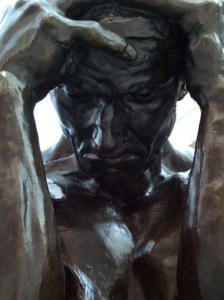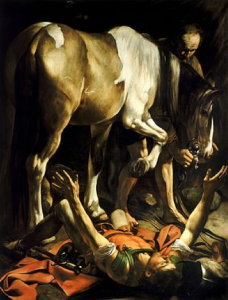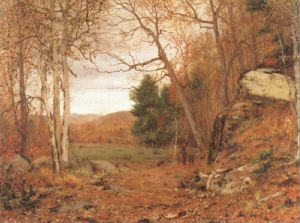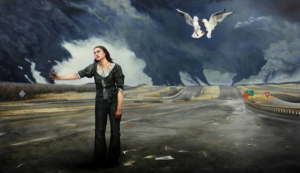Detail from one of Rodin’s “Burghers of Calais”
[Originally published in 2015]
Wired UK and other media outlets report that computer scientists Ahmed Elgammal and Babak Saleh from Rutgers University have developed a visual algorithm which they believe can accurately rank historical artworks according to their creativity. Elgammal and Saleh define creativity as “the originality of the product and its influential value.” They use this definition to create what has been called an art network based on paintings’ (and some sculptures’) similarity to earlier works. Their experiment evaluated a variety of elements including color, texture and type of scenes depicted. Elgammal and Saleh compiled a database of art works from the 1400s to the present and used their algorithm to draw parallels between creative works.
This study, which purports to use computer science to measure the absolute creative worth of over 62,000 original works of art, is highly subjective and filled with inherent bias despite the programmers’ efforts to tease out evaluative absolutes by setting strict criteria. They seem to have assumed that their criteria covered the most important elements of what makes a work original or creative. Sadly, the whole enterprise and is at best flawed and at worst counterproductive to an accurate appraisal and understanding of what makes great works of art great.
A primary problem with such a test is determining what works to include and by which artists. For example, one artist who fared poorly in this project’s evaluation is August Rodin, an immensely popular French sculptor who has had an extraordinary impact on sculptors who came after him. Rodin is best known by the general public for two works, “The Thinker” and “The Kiss,” which are, to my mind, among his less exciting pieces. Indeed, “The Thinker” was conceived as a small part of his masterwork, “The Gates of Hell,” a monumental sculptural bronze work which depicts scenes from Dante’s Inferno, and versions of “The Thinker” appear in each of the cast bronze versions of the gates on display in museums around the world. Those who study and collect art are generally much more excited about “The Gates of Hell” and Rodin’s “Burghers of Calais,” which are considered his most emotionally powerful works. Each was cast in multiple versions and is displayed in numerous locations around the globe.
“The Gates of Hell,” a bronze gate covered in writhing bodies, and the somber collection of chained men dressed in rags that makes up “The Burghers of Calais” are, I would argue, more important to the development of 20th century sculpture than “The Thinker” or “The Kiss.” They are, however, much less well-known among those who only have a cursory interest in art. These more influential works are deeply psychological and disturbing sculptures featuring people in torment, not the placid, pleasing sculptures that those who know little of Rodin’s work may think of when they hear his name. Rodin, who lived a long, passionate and prolific life, created thousands of heads, bodies and body parts of clay and bronze and he created portrait sculptures that sometimes offended those who posed for them with their raw, unfinished, often ugly qualities. For more than a century, serious students of art have studied and copied Rodin’s work and techniques, and his more distorted and disturbing sculptures have been among the most influential works of the last 150 years among modern artists.
If your specialty is programming and not art, you might not know to include those works among your sample. You might choose only his more generally popular works and assume that because they are more frequently copied, photographed or parodied, they are the more important pieces. And if you do that, you’ll get a skewed result, which is exactly what happened.
This study is getting a great deal of attention because of what was written about it by Daniel Culpan of Wired UK and in careless quotations of his work by other publications. Mr. Culpan is not conversant enough with art history to know basic terminology about the discipline. He did not appear to know enough about the subject to challenge some of the computer scientists’ biases and assumptions, and he apparently did not fully read even the short precis of the paper which he seems to have skimmed. He failed to mention, for example, that the artworks include not only paintings but also sculptures. The republication of and references to his article by Ars Technica and Smithsonian both repeat this error. Also, the art historical term “old masters,” which Mr. Culpan apparently erroneously believes means all important artists of the pre-20th century period, actually has a more specific meaning and commonly refers to works painted from approximately the 13th to the 18th centuries, up to about the year 1800.
Two of the artists Culpan describes as “old masters” who rated poorly in the computer assessment of their creativity actually lived and worked significantly after the “old masters” period: Ingres painted in the late 18th and early 19th centuries; Rodin sculpted in the late 19th and early 20th centuries. They are artists we consider to be part of the canon, but Ingres predates the modern era by only a few decades, and Rodin worked during what most art historians would consider to be the modern era.
Some wonder whether this study “proves” that some long-lauded artists might have been overvalued by those who lived before computer-aided evaluations were available. In the cases of Ingres and Rodin, their works (and Rodin’s in particular) are so unlike any others by their contemporaries that they are easily recognizable as having been created by those masters. I would argue that Ingres and especially Rodin were powerfully influential and that they saw things with a different eye than those who came before them. However, they worked primarily with traditional subject matter—figurative portraiture—in recognizable ways; i.e., their subjects’ body parts are generally recognizable as such and appear in the name locations as real body parts do, unlike paintings or sculptures by artists like Picasso, say, who moved eyes and limbs around on the bodies of the subjects he painted.
Sometimes Picasso painted multiple views of the same body part from different angles and incorporated them all into one portrait. Artists like Matisse distorted the colors of body parts, painting faces green or red when it suited him. Such altering of basic elements of human anatomy in one’s art could be considered more creative, and showing creativity (according to this definition) could be considered to be a better or more advanced form of art, or more impressive or important than producing images based more closely on figurative norms. Making recognizable portrait paintings of nobility, as Ingres did, could be seen as less “creative” than building most of one’s oeuvre out of stacked boxes and lines, like Mondrian, or collages, like Braque, or simplifying figures to their essential shapes and distorting them, like Munch or Picasso or Dali or Lichtenstein. But reducing creativity to such simplistic, easily measured or described metrics is unfair and damaging if it allows us to discount the importance, beauty, influence and ineffable magic found in historically earlier, more subtle or more “mainstream” works of art.
Taking these works out of their historical settings does them a disservice in determining how influential they were on the art that followed. The creators of this study tried to determine the influence of artists on those who followed them and to determine how different they were from what came before. But such differences were much more subtle during earlier centuries, and changes in style usually came about more slowly in past centuries than they did from the mid-19th century onward. Changes in art sped up throughout the 20th century, and now there are so many competing styles, media, techniques, mindsets, methodologies and concepts that one can no longer describe a prevailing artistic sensibility as being representative of the modern era. Technology and speed of communications changed artists’ ability to influence each other, and that sped up creativity, by one measure of the term. But since we modern types tend to think of “creativity” as an inherently positive term, I fear conflating the idea that something is “different” and therefore more “creative” in some ways with the idea that it is therefore better or more valuable.
In past times, the differences between two styles of art could be seen as monumentally important to earlier artists or to professional art historians, but those differences might be almost imperceptible to modern people without training and context. For example, Early Renaissance master sculptor Donatello and High Renaissance master sculptor Michelangelo each created important statues of the biblical figure David between about 1440 and 1504, and those who study art history see them as vastly different in feeling, symbolism, strength, influence and style. Someone without training, however, might very well see them as two boring, traditional nude dudes. Someone with no training at all can look at paintings by Salvador Dali, Rene Magritte and Andy Warhol side by side and see that each is different from the other and none is like anything seen before, and by that measure they could be seen as much more original, creative or even valuable than the works of Michelangelo. Each of those artists is hugely important and influential, but to put Magritte into the same category as Michelangelo would be ridiculous and unfair. Michelangelo’s works’ relative similarity to sculptures done by Roman artists 1500 years earlier does not make him a less creative or important or original artist for having copied and appropriated techniques from ancient works so well.
I fear any project that would use loaded terms like “creative” to rank, describe or value artists is likely to mislead those outside of the art world into believing that there are absolutes and discernible metrics that one can use to boil artworks down to their essence and take the guesswork out of determining meaning or value or rank. Such a ranking tool cannot exist because an essential element of art is that it can be valued in multiple ways, and that a work’s value is not solely the price for which it can be sold but is also derived from the meaning it has for the creator and its viewers. One can no more value a work of art than one can a human life. Yes, it can technically be done in a court of law or an auction showroom, but each of us holds a particular person or possession dearer than any court or auction house would, and we would argue that that person’s or thing’s imputed value has nothing to do with the value we sense within our head and heart. That is what makes art great and more complex in meaning than a garden hose or a box of cash. Each of us brings our own meaning to and derives our own value from a work of art in a unique way, and a computer program cannot do that for us.
According to this computerized assessment of relative creativity, Munch’s “The Scream” is on a par with Velazquez’s entire artistic output. In actuality, Munch’s dark, disturbed paintings owe much to the interior moodiness of 17th and 18th century masters like Velazquez and Goya, just as the nihilistic artists and writers of the late 19th and early 20th centuries could not exist without the influence of the writers and artists who came before. To take them out of context and rank them in this raw and bloodless way feels, to me, preposterous.
Margaret Keene’s big-eyed portraits of the 1950s and 1960s were distinctive and immediately recognizable and they inspired many copies. These aspects of her work could be considered signs of great creativity according to descriptions of elements considered by this study. Keene’s works are, however, generally considered to be kitschy, shallow and lacking in artistic merit. Rodin, on the other hand, created rough, lumpy, often ugly portraits that many believed looked half-finished or hideous, but this freshness and openness to a reassessment of what constitutes a completed form had huge influence on modern sculpture. However, most people who know little about art history are only familiar with his statues “The Thinker” and “The Kiss,” which are more smooth, finished and conservative in their style than most of his works and are less appropriate examples of the originality and influence of his work on artists themselves. I think his scoring so poorly on this “test” of creativity better shows the weakness of the creators’ understanding of which works of his should be evaluated and included in the test than it does the level of his creativity.
The project is interesting, and it is heartening to see people in tech fields showing an interest in the fine arts. However, the metrics the project uses to measure artistic merit are biased more toward novelty than quality, and they discount many of the key elements of artworks most prized by professional art historians and collectors. Elgammal and Saleh make so many value judgments based on personal opinion that the result is a controversial evaluative tool of very limited use.





